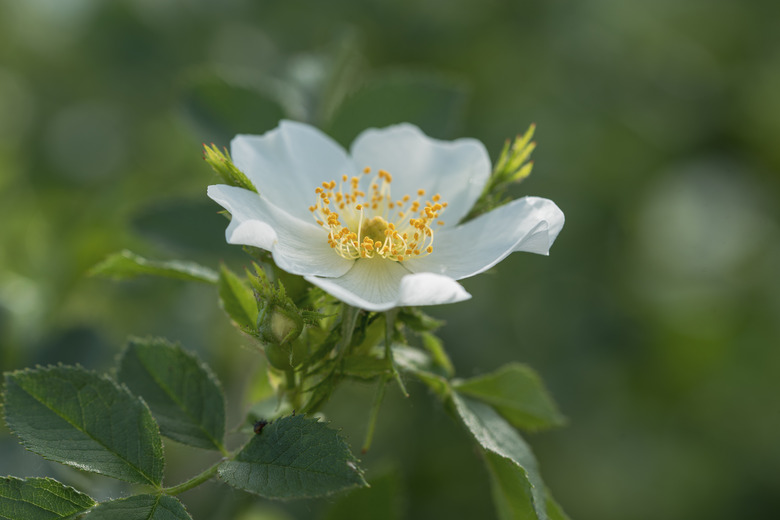How To Clear Thorn Bushes
Whether you planted some shrubs with thorns or they decided to invade your landscape on their own, controlling them can turn into a prickly nightmare. This is especially true if the bushes have taken over an area without any effort to stop their growth. Although clearing the patch of thorny nastiness will take a bit of work and time, with continued attention, you'll soon be able reclaim the area and make it thorn-free.
Invasive Types of Thorn Bushes
There are numerous types of thorn bushes that are desirable landscape plants, but many thorny bushes are considered invasive. These invasive bushes infiltrate a landscape and quickly take over an area, especially when no control measures are put into effect. Their growth can choke out your desirable plants and leave the area a thorn-filled mess.
A common and thorny invasive plant is the multiflora rose (Rosa multiflora, USDA zones 4 through 8). Considered invasive in a host of different areas, the multiflora rose quickly forms dense, thorny thickets that are impenetrable and can displace native plantings. The Asian native first came to North America for use as the rootstock for ornamental roses in 1866. In the mid-1900s, due to its impenetrable qualities, the multiflora rose was utilized as a living fence to keep livestock contained. Bushes can grow 15 feet tall with thorny, arching branches lined with serrated leaves and sporting small pink to white blooms in spring.
Another thorny invasive is the Himalayan blackberry (Rubus armeniacus, USDA zones 4 through 8). Native to Armenia, this perennial bush was introduced to North America in 1885 for the production of the sweet-tasting fruits and has since escaped control, forming dense, thorny thickets that displace native plants. Plants easily spread by seeds or where the cane tips touch the ground. Bushes quickly reach a mature height of 32 feet, filled with arching canes of serrated foliage and hooklike thorns. In late spring, the bush fills with white to pink blooms followed by the edible fruits.
Removing Bushes by Physical Means
If you feel up for a workout, you can remove some thorny bushes by physically digging, hoeing, or cutting the unwanted plants. Depending on the particular plant, the sap of some can be toxic and can cause allergic reactions when it comes in contact with skin. If you attack the thicket unprepared, you can almost bet you'll end up with cuts and scrapes from the thorns. When attacking the thorny bushes, protect yourself by wearing long sleeves, long pants, eye protection, thick gloves and closed-toe shoes.
When it comes to the needed tools, a spade shovel, loppers, handsaw, and hand clippers will work well in removing the bushes. Depending on the size and depth of the root system, you might be able to remove the bushes by digging them up from the ground, being sure to obtain the entire root system so it doesn't sprout back. You can also cut the bushes down to the ground using a hand saw, loppers, or hand clippers, making it easier to dig in the area to retrieve the roots.
Removal Using Herbicides
If removing the unwanted bushes by digging out the root system isn't possible or some of the roots remain, you can opt for killing the plants using herbicides. You will still need to wear protective clothing so you don't get scratched by the thorns, and cutting down the plants first produces the best results. Regardless of the option you choose to get rid of the bushes, you're still going to have to physically come in contact with the thorny branches.
You'll want to do the work on a sunny day that isn't windy and when rain isn't forecast so the herbicide has time to dry. Cut the bushes close to the ground, leaving a bit of the branches at the base exposed so you have an area to place the herbicide. Use a product containing glyphosate and once you cut the branches, either spray the area with glyphosate or paint it onto the exposed area. You should see results in about a week, and you may have to reapply it several times before the bushes completely die.
